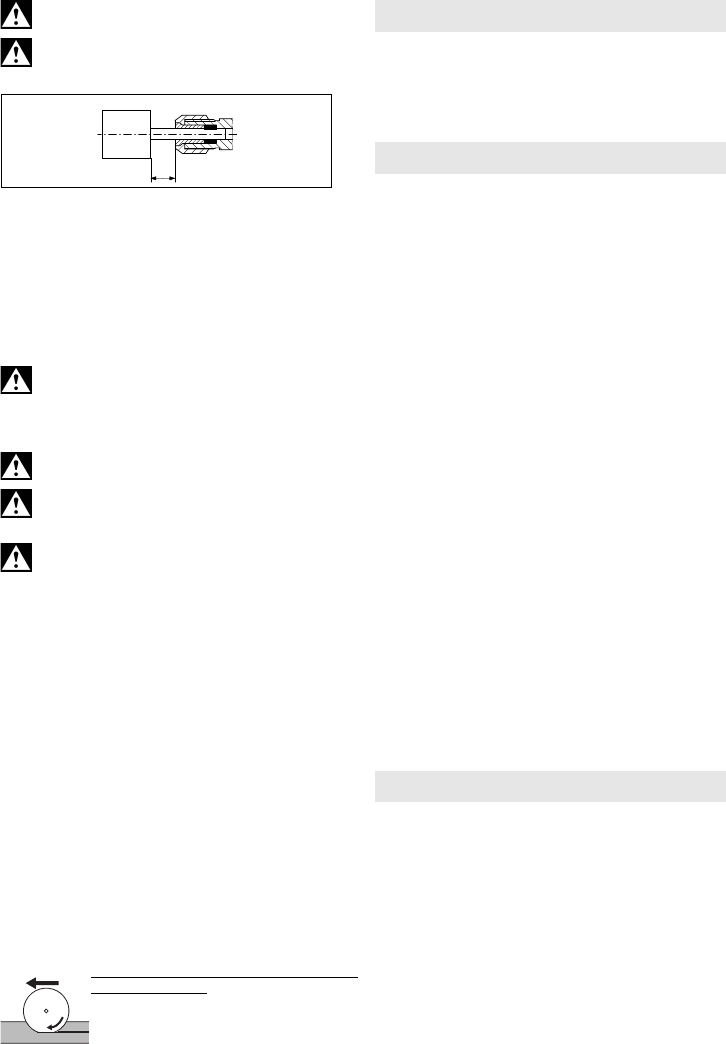
ENGLISH en
9
The tool's shank diameter must correspond
exactly to the collet bore of the collet chuck (1)!
For abrasive points, you must never exceed
the maximum open shank length specified by
the manufacturer l
0
.
Insert the tool (with the full length of the shank) in the
collet chuck (1).
Bring the spindle to a standstill. (For the
GE 710 Compact, use the 13-mm spanner provided
for this purpose. For the GA 18 LTX, GE 710 Plus,
GA 18 LTX G and GE 950 G Plus, press the spindle
locking button (4)).
Using the 19-mm spanner, tighten the collet chuck
nut (2).
If there is no tool inserted in the collet chuck,
you can tighten the collet chuck manually
rather than with the spanner.
6.3 Switching On and Off
Switch on first, then guide the
accessory
towards the workpiece.
Avoid inadvertent starts: always switch the
tool off when the plug is removed from the
mains socket or if there has been a power cut.
In continuous operation, the machine
continues running if it is forced out of your
hands. You must therefore always hold the machine
with both hands using the handles provided (3), (5),
(7), stand in a safe position and concentrate while
working.
Switching on: Push the slide switch (6) forward.
For continuous activation, now tilt downwards until
it engages.
Switching off: Press the rear end of the slide
switch (6) and release.
6.4 Adjusting speed (mains powered
machines only)
The speed can be preset using the setting wheel (8)
and is infinitely variable. For a list of speeds, see the
table on page 3.
6.5 Working instructions
Grinding, sanding, polishing or using wire
brushes: Press down the machine evenly and
move it from side to side over the surface.
Routing: Press down the machine evenly.
Separating:
Always work against the run of the disc
(see illustration). Otherwise there is
the danger of the machine kicking
back from the cut out of control. Guide
the machine evenly at a speed suit-
able for the material being processed. Do not tilt,
apply excessive force or sway from side to side.
7.1 Motor cleaning
To clean the motor, apply jets of compressed air
through the rear ventilation slots of the machine
regularly, frequently and thoroughly. Here, the
machine must be held firmly.
8.1 Mains powered machines:
- Overload protection: There is a MAJOR
reduction in load speed. The motor temperature
is too high! Allow the machine to run at idle speed
until it has cooled down.
- Overload protection: There is a SLIGHT
reduction in load speed. The machine is over-
loaded. Reduce the load before continuing to
work.
- Metabo S-automatic safety shutdown: The
machine was SWITCHED OFF automatically. If
the slew rate of the current is too high (for
example, if the machine suddenly seizes or kick-
back occurs), the machine switches off. Switch off
the machine at the slide switch (6). Switch it on
again and continue to work as normal. Try to
prevent the machine from seizing. See section
3.2.
- Restart protection: The machine does not
start. The restart protection is active. If the mains
plug is inserted with the machine switched on, or if
the current supply is restored following an inter-
ruption, the machine does not start up. Switch the
machine off and on again.
8.2 Cordless machines:
- The electronic signal display (10) lights up
and the load speed decreases. The tempera-
ture is too high! Run the machine in idling until the
electronics signal indicator switches off.
- The electronic signal display (10) flashes and
the machine does not start. The restart protec-
tion is active. The machine will not start if the
battery pack is inserted while the machine is on.
Switch the machine off and on again.
Use only genuine Metabo accessories.
Use only accessories which fulfil the requirements
and specifications listed in these operating instruc-
tions.
Fit accessories securely. Secure the machine if it is
operated in a bracket. Loss of control can cause
personal injury.
A Collets (including nut)
dia.
3 mm = 6.31947
dia.
1/8“ = 6.31948
dia.
6 mm = 6.31945
dia.
1/4“ = 6.31949
dia.
8 mm = 6.31946
B Clamping frame 6.27354 for clamping during
work with flexible shafts (tighten clamping
l
o
7. Cleaning
8. Troubleshooting
9. Accessories


















